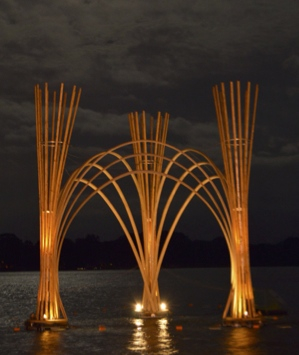A State Captain’s Final Log: The Future is in Our Very Creative Hands
Posted by Feb 28, 2017

John Schratwieser
One of my first trips as Director of Maryland Citizens for the Arts (MCA) was to the small, western Maryland industrial-town of Cumberland. Known as “Queen City,” Cumberland was Maryland’s second largest city in the 19th century thanks to the three R’s: roads, rails, and rivers. Arriving, one might expect to see a typical forgotten rust-belt town. Well, not this town! Cumberland became an Arts & Entertainment District in 2002, one of Maryland’s first. The management team targeted artists looking for affordable space and great proximity to major markets. The downtown felt as vibrant as any I’d seen, and there was a provincial feeling in the air—in the best sense of the word. I met the first of hundreds of artists, administrators, and arts advocates that I would meet over my seven years on the job at MCA. These are the people that have—together with thoughtful and committed lawmakers from both parties—propelled Maryland to being fourth in the nation in per-capita funding for the arts. Cities and towns all over Maryland are using the arts to revive the economy, strengthen communities, educate our young people, and create a sense of belonging for our citizens. As a sector, Maryland’s nonprofit arts are a $1.16 billion industry, supporting nearly 15,000 full time jobs, and generating $54 million in tax revenue for the state—a 3:1 return on the state’s annual appropriation.
 Advocacy was not new to me when I arrived at MCA, but I never expected to have so many examples of impactful stewardship of public investment as I found all over Maryland. From the use of needle point panels to teach about the Holocaust at The American Visionary Art Museum, to a powerful dance feature created by Liz Lerman at Dance Exchange based on the origins of human development; and, from an inspired “barn quilt” trail in Western Maryland highlighting this traditional craft’s role in Maryland’s tradition, to an inspired temporary public art installation for Chestertown River Arts on the Eastern Shore focusing attention on our critical estuary the Chesapeake Bay and its role in our past, present and future—artists all over Maryland are using the arts to bring us closer, expand our understanding, and support our future. For 40 years, MCA has led the advocacy efforts for an annual arts appropriation. Our work is fueled by success stories like these; artists using their work to educate, engage, and create empathy. After seven years, when I meet with lawmakers about arts funding, I’ve got a cache of hundreds of stories, covering every legislative district, of the benefits (both economic and cultural) of the state’s investment in the arts.
Advocacy was not new to me when I arrived at MCA, but I never expected to have so many examples of impactful stewardship of public investment as I found all over Maryland. From the use of needle point panels to teach about the Holocaust at The American Visionary Art Museum, to a powerful dance feature created by Liz Lerman at Dance Exchange based on the origins of human development; and, from an inspired “barn quilt” trail in Western Maryland highlighting this traditional craft’s role in Maryland’s tradition, to an inspired temporary public art installation for Chestertown River Arts on the Eastern Shore focusing attention on our critical estuary the Chesapeake Bay and its role in our past, present and future—artists all over Maryland are using the arts to bring us closer, expand our understanding, and support our future. For 40 years, MCA has led the advocacy efforts for an annual arts appropriation. Our work is fueled by success stories like these; artists using their work to educate, engage, and create empathy. After seven years, when I meet with lawmakers about arts funding, I’ve got a cache of hundreds of stories, covering every legislative district, of the benefits (both economic and cultural) of the state’s investment in the arts.
But the process isn’t perfect. We are working off a funding model created 20+ years ago. We know there are voices which are not at the table. We know there are barriers—particularly for smaller organizations and individual artists—to funding, programming, and more. As we gather in Washington, DC, on March 20-21 for Arts Advocacy Day, we know that part of our task is to move the needle on arts policy through a lens of diversity, access, and innovation. Our advocacy needs to move too. The economics argument is solid, and it’s been our drum beat. But it is the social impact argument that needs to take wing—what we arts folk have coined as the “Arts &” argument. Whether it’s healthcare, public transportation, safe and affordable housing, or the environment—artists have the tools and the talents to turn the tide. I advocate for the arts because I have seen first-hand its transformational power. I have seen the arts break down walls. I have seen the arts heal. I have seen the arts lift communities. In the end, as you’ve heard, a civilization is remembered most by its artistic and cultural heritage it leaves behind. Every voice matters, so raise yours, and tell others to raise theirs. It’s our future, and it is in our very creative hands. We will only be successful if we remember that sometimes, you really do need to color outside the lines.
This post is part of a series of advocacy blogs leading up to Arts Advocacy Day 2017. Read more advocacy blogs here.





